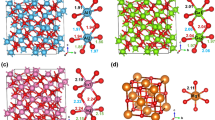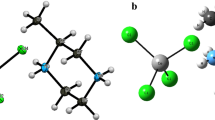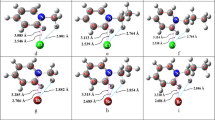Abstract
In the current research, a comprehensive study is performed on the non-covalent interactions of the acetaminophen complex in the presence of various solvents. In addition, the effect of cation–π interaction on the strength and nature of the intramolecular hydrogen bond (H-bond) is explored by density functional theory method. The computations are performed using the M06-2X functional and the 6-311++G(d,p) basis set. The obtained results reveal that both interactions become stronger in the gas phase with respect to the solution phase. The “atoms in molecules” theory and the natural bond orbital method are also applied to get more details about the investigated interactions character. Based on the achieved outcomes, the H-bond of the studied complex is placed in the weak H-bond category. Our findings indicate that the intramolecular H-bond is strengthened by the cation–π interaction in the different solvents. Finally, the physical properties such as frontier molecular orbitals, energy gap, dipole moment, chemical hardness as well as electronic chemical potential are investigated to evaluate the electronic properties, stability and reactivity of the studied complex.






Similar content being viewed by others
References
Peter JZ, Pharm D, Edward PK, Pharm D, ABAT (1991) Treatment of acetaminophen overdose. Am J Health Syst Pharm 56:1081–1091
Lee WM (2017) Acetaminophen (APAP) hepatotoxicity-Isn’t it time for APAP to go away? J Hepatol 67:1324–1331
Mangus BC, Miller MG (2005) Pharmacology application in athletic training. F.A Davis Company, Philadelphia
Hamilton RJ (2013) Tarascon pocket pharmacopoeia: 2013 classic shirt-pocket edition. Jones & Bartlett Learning, Burlington
McKay GA, Walters MR (2013) Clinical pharmacology and therapeutics. Wiley, Hoboken
Ghanem CI, Pérez MJ, Manautou JE, Mottino AD (2016) Acetaminophen from liver to brain: new insights into drug pharmacological action and toxicity. Pharmacol Res 109:119–131
Viswanathan AN, Feskanich D, Schernhammer ES, Hankinson SE (2008) Aspirin, NSAID, and acetaminophen use and the risk of endometrial cancer. Cancer Res 68:2507–2513
Larson AM, Polson J, Fontana RJ, Davern TJ, Lalani E, Hynan LS, Reisch JS, Schiødt FV, Ostapowicz G, ObaidShakil A, Lee WM (2005) Acetaminophen-induced acute liver failure: results of a United States multicenter, prospective study. Hepatology 42:1364–1372
Ricciotti E, FitzGerald GA (2011) Prostaglandins and inflammation Arterioscler. Thromb Vasc Biol 31:986–1000
Hinz B, Cheremina O, Brune K (2008) Acetaminophen (paracetamol) is a selective cyclooxygenase-2 inhibitor in man. FASEB J 22:383–390
Muller-Dethlefs K, Hobza P (2000) Noncovalent interactions: a challenge for experiment and theory. Chem Rev 100:143–167
Masoodi HR, Bagheri S, Ranjbar M (2016) Theoretical study of cooperativity between hydrogen bond-hydrogen bond, halogen bond-halogen bond and hydrogen bond-halogen bond in ternary FX···diazine···XF (X = H and Cl) complexes. Mol Phys 114:3464–3474
Samimi HA, Esrafili M, Mohammadian-Sabet F, Haddadi H (2015) Theoretical study on cooperative interplay between anion–π and chalcogen-bonding interactions. Mol Phys 113:1442–1450
Nowroozi A, Roohi H, Sadeghi MS, Sheibaninia M (2011) The competition between the intramolecular hydrogen bond and π-electron delocalization in trifluoroacetylacetone—a theoretical study. Int J Quantum Chem 111:578–585
Esrafili M, Yourdkhani S, Bahrami A (2013) Characteristics and nature of the halogen-bonding interactions between CCl3F and ozone: a supermolecular and SAPT study. Mol Phys 111:3770–3778
Nowroozi A, Roohi H, Poorsargol M, Mohammadzadeh Jahani P, Hajiabadi H, Raissi H (2011) N–H···S and S–H···N intramolecular hydrogen bond in β-thioaminoacrolein: a quantum chemical study. Int J Quantum Chem 111:3008–3016
Oshovsky GV, Reinhoudt DN, Verboom W (2007) Supramolecular chemistry in water. Angew Chem Int Ed 46:2366–2399
Saalfrank RW, Maid H, Scheurer A (2008) Supramolecular coordination chemistry: the synergistic effect of serendipity and rational design. Angew Chem Int Ed 47:8794–8824
Steiner T (1997) Unrolling the hydrogen bond properties of C–H···O interactions. Chem Commun 8:727–734
Steiner T, Desiraju R (1998) Distinction between the weak hydrogen bond and the van der Waals interaction. Chem Commun 8:891–892
Kodama Y, Nishihata K, Nishio M, Nakagawa N (1977) Attractive interaction between aliphatic and aromatic systems. Tetrahedron Lett 18:2018–2105
Hobza P, Havlas Z (2000) Blue-shifting hydrogen bonds. Chem Rev 100:4253–4264
Umezawa Y, Tsuboyama S, Takahashi H, Uzawa J, Nishio M (1999) CH···π interaction in the conformation of organic compounds. A database study. Tetrahedron 55:10047–10056
Ungaro R, Pochini A, Andreeti GD, Sangermano V (1984) Molecular inclusion in functionalized macrocycles. Part 8. The crystal and molecular structure of calix[4]arene from phenol and its (1: 1) and (3: 1) acetone clathrates. J Chem Soc Perkin Trans 2(12):1979–1985
Kobayashi K, Asakawa Y, Kato Y, Aoyama Y (1992) Complexation of hydrophobic sugars and nucleosides in water with tetrasulfonate derivatives of resorcinol cyclic tetramer having a polyhydroxy aromatic cavity: importance of guest-host CH–π interaction. J Am Chem Soc 114:10307–10313
Cubero E, Luque FJ, Orozco M (1998) Is polarization important in cation–π interactions? Proc Natl Acad Sci 95:5976–5980
Ma JC, Dougherty DA (1997) The cation–π interaction. Chem Rev 97:1303–1324
Lehn JM (1995) Supramolecular chemistry: concepts and perspectives. VCH Weinheim, Berlin
Steed JW, Atwood JL (2000) Supramolecular chemistry. Wiley, West Sussex
Fischer E, Dtsch B (1894) Einfluss der Configuration auf die Wirkung der Enzyme. Chem Ges 27:2985–2993
Rooman M, Liévin J, Buisine E, Wintjens R (2002) cation–π/H-bond stair motifs at protein-DNA interfaces. J Mol Biol 319:67–76
Starellas C, Escudero D, Frontera A, Quinonero D, Deya PM (2009) Theoretical ab initio study of the interplay between hydrogen bonding, cation–π and π–π interactions. Theor Chem Account 122:325–332
Escudero D, Frontera A, Quiñonero D, Deyà PM (2008) Interplay between cation–π and hydrogen bonding interactions. Chem Phys Lett 456:257–261
Yong-gan Y, Wen-jing S, Guo-rui F, Fu-de R, Yong W (2012) A B3LYP and MP2 (full) theoretical investigation on the cooperativity effect between cation-molecule and hydrogen-bonding interactions in the O-cresol complex with Na+. Comput Theor Chem 996:91–102
Qingzhong L, Wenzuo L, Jianbo C, Baoan G, Jiazhong S (2008) Effect of methyl group on the cooperativity between cation–π interaction and NH···O hydrogen bonding. J Mol Struct Theochem 867:107–110
Garcia-Raso A, AlbertíF M, Fiol JJ, Tasada A, Barceló-Oliver M, Molins E, Escudero D, Frontera A, Quiñonero D, Deyà PM (2007) Anion − π interactions in bisadenine derivatives: a combined crystallographic and theoretical study. Inorg Chem 46:10724–10735
Greenaway F (1995) Structural aspects of metal ion-drug interactions, handbook of metal-ligand interactions in biological fluids, bioinnorganic chemistry. Marcel Dekker, New York
Ai H, Bu Y, Li P, Li Z, Hu X, Chen Z (2005) Geometry and binding properties of different multiple-state glycine–Fe+/Fe2+ complexes. J Phys Org Chem 18:26–34
Banu L, Blagojevic V, Bohme DK (2012) Dissociation of deprotonated glycine complexes with Pb2+ and five transition-metal dications (Fe2+, Co2+, Ni2+, Cu2+, Zn2+): the importance of metal bond activation. Int J Mass Spectrom 330–332:168–173
Marino T, Toscano M, Russo N, Grand A (2006) Structural and electronic characterization of the complexes obtained by the interaction between bare and hydrated first-row transition-metal ions (Mn2+, Fe2+, Co2+, Ni2+, Cu2+, Zn2+) and glycine. J Phys Chem B 110:24666–24673
Rodgers MT, Armentrout PB (2004) A thermodynamic, “vocabulary” for metal ion interactions in biological systems. Acc Chem Res 37:989–998
Campbell NRC, Hasinoff BB (1991) Iron supplements: a common cause of drug interactions. Br J Clin Pharm 31:251–255
Mohamed Issa M, Mahmoud Nejem R, Abu Shanab A (2013) Effects of iron on the pharmacokinetics of paracetamol in saliva. Pak J Biol Sci 16:2050–2053
Moffat AC, Osselton MD, Widdop B, Watts J (2011) Clarkes analysis of drug and poisons. Pharmaceutical Press, London
Sunagane N, Yoshibu E, Murayama N, Terawaki Y, Uruno T (2005) Simple method for precognitions of drug interaction between oral iron and phenolic hydroxyl group-containing drugs. Yakugaku Zasshi 125:197–203
Campbell NA, Hasinoff B (1989) Ferrous sulfate reduces levodopa bioavailability: chelation as a possible mechanism. Clin Pharmacol Therapeut 45:220–225
Campbell NRC, Rankine D, Goodrige AE, Hasinoff BB, Kara M (1991) Sienemet-ferrous sulphate interaction in patients with Parkinson disease. Br J Clin Pharmacol 30:559–605
Demircan ÇA, Bozkaya U (2017) Transition metal cation–π interactions: complexes Formed by Fe2+, Co2+, Ni2+, Cu2+, and Zn2+ binding with benzene molecules. J Phys Chem A 121(34):6500–6509
Yi HB, Lee HM, Kim KS (2009) Interaction of benzene with transition metal cations: theoretical study of structures, energies, and IR spectra. J Chem Theory Comput 5:1709–1717
Molina JM, Dobado JA, Melchor S (2002) Structural and electronic effects of the interaction of metal cations with benzene. J Mol Struct (Theochem) 589–590:337–347
Kolakkandy S, Pratihar S, Aquino AJA, Wang H, Hase WL (2014) Properties of complexes formed by Na+, Mg2+, and Fe2+ binding with benzene molecules. J Phys Chem A 118:9500–9511
Frisch MJ, Trucks GW, Schlegel HB, Scuseria GE, Robb MA, Cheeseman JR, Montgomery JA Jr, Vreven T, Kudin KN, Burant JC, Millam JM, Iyengar SS, Tomasi J, Barone V, Mennucci B, Cossi M, Scalmani G, Rega N, Petersson GA, Nakatsuji H, Hada M, Ehara M, Toyota K, Fukuda R, Hasegawa J, Ishida M, Nakajima T, Honda Y, Kitao O, Nakai H, Klene M, Li X, Knox JE, Hratchian HP, Cross JB, Bakken V, Adamo C, Jaramillo J, Gomperts R, Stratmann RE, Yazyev O, Austin AJ, Cammi R, Pomelli C, Ochterski JW, Ayala PY, Morokuma K, Voth GA, Salvador P, Dannenberg JJ, Zakrzewski VG, Dapprich S, Daniels AD, Strain MC, Farkas O, Malick DK, Rabuck AD, Raghavachari K, Foresman JB, Ortiz JV, Cui Q, Baboul AG, Clifford S, Cioslowski J, Stefanov BB, Liu G, Liashenko A, Piskorz P, Komaromi I, Martin RL, Fox DJ, Keith T, Al-Laham MA, Peng CY, Nanayakkara A, Challacombe M, Gill PMW, Johnson B, Chen W, Wong MW, Gonzalez C, Pople JA (2003) Gaussian 03 (Revision A.7). Gaussian Inc., Pittsburgh
Zhao Y, Truhlar DG (2008) The M06 suite of density functionals for main group thermochemistry, thermochemical kinetics, noncovalent interactions, excited states, and transition elements. Theor Chem Acc 120:215–241
Zhao Y, Schultz NE, Truhlar DG (2005) Exchange-correlation functional with broad accuracy for metallic and nonmetallic compounds, kinetics, and noncovalent interactions. J Chem Phys 123:161103-1–161103-4
Zhao Y, Schultz NE, Truhlar DG (2006) Design of density functionals by combining the method of constraint satisfaction with parametrization for thermochemistry, thermochemical kinetics, and noncovalent interactions. J Chem Theory Comput 2:364–382
Zhao Y, Truhlar DG (2006) A new local density functional for main-group thermochemistry, transition metal bonding, thermochemical kinetics, and noncovalent interactions. J Chem Phys 125:194101-1–194101-18
Zhao Y, Truhlar DG (2007) Density functionals for noncovalent interaction energies of biological importance. J Chem Theory Comput 3:289–300
Miertus S, Scrocco E, Tomasi J (1981) Electrostatic interaction of a solute with a continuum: a direct utilizaion of AB initio molecular potentials for the prevision of solvent effects. Chem Phys 55:117–129
Espinosa E, Molins E (2000) Retrieving interaction potentials from the topology of the electron density distribution: the case of hydrogen bonds. J Chem Phys 113:5686–5694
Boys SF, Bernardi F (1970) The calculation of small molecular interactions by the differences of separate total energies. Some procedures with reduced errors. Mol Phys 19:553–566
Bader RFW (1990) Atoms in molecules: a quantum theory. Oxford University Press, Oxford
BieglerKönig F, Schönbohm J (2002) Update of the AIM2000-program for atoms in molecules. J Comput Chem 23:1489–1494
Reed AE, Curtiss LA, Weinhold F (1988) Intermolecular interactions from a natural bond orbital, donor-acceptor viewpoint. Chem Rev 88:899–926
Glendening ED, Reed AE, Carpenter JE, Weinhold F (2003) NBO, version 3.1 (in). Gaussian, Inc., Pittsburg, CT
Yoosefian M, Ansarinik Z, Etminan N (2016) Density functional theory computational study on solvent effect, molecular conformations, energies and intramolecular hydrogen bond strength in different possible nano-conformers of acetaminophen. J Mol Liq 213:115–121
Marshall MS, Steele RP, Thanthiriwatte KS, Sherrill CD (2009) Potential energy curves for cation–π interactions: off-axis configurations are also attractive. J Phys Chem A 113:13628–13632
Bader RFW (1991) A quantum theory of molecular structure and its applications. Chem Rev 91:893–928
Feynman RP (1939) Forces in molecules. Phys Rev 56:340–343
Grabowski SJ, Sokalski WA, Dyguda E, Leszczyński J (2006) Quantitative classification of covalent and noncovalent H-bonds. J Phys Chem B 110:6444–6446
Espionsa E, Souhassou M, Lachekar H, Lecomte C (1999) Topological analysis of the electron density in hydrogen bonds. Acta Crystallogr B 55:563–572
Abramov YA (1997) On the possibility of kinetic energy density evaluation from the experimental electron-density distribution. Acta Crystallogr A 53:264–272
Carroll MT, Chang C, Bader RFW (1988) Prediction of the structures of hydrogen-bonded complexes using the Laplacian of the charge density. Mol Phys 63:387–405
Carroll MT, Bader RFW (1988) An analysis of the hydrogen bond in BASE-HF complexes using the theory of atoms in molecules. Mol Phys 65:695–722
Vijayakumar S, Kolandaivel P (2005) Red-shifted and improper blue-shifted hydrogen bonds in dimethyl ether (DME)n (n = 1–4) and hydrated (DME)n (n = 1–4) clusters: a theoretical study. J Mol Struct 734:157–169
Koch U, Popelier PLA (1995) Characterization of C-H–O hydrogen bonds on the basis of the charge density. J Phys Chem 99:9747–9754
Popelier PLA (1998) Characterization of a dihydrogen bond on the basis of the electron density. J Phys Chem A 102:1873–1878
Gálvez O, Gómez PC, Pacio LF (2003) Variation with the intermolecular distance of properties dependent on the electron density in cyclic dimers with two hydrogen bonds. J Chem Phys 118:4878–4895
Domagala M, Grabowski SJ (2005) CH…N and CH…S hydrogen bonds. Influence of hybridization on their strength. J Phys Chem A 109:5683–5688
Raissi H, Yoosefian M, Moshfeghi E, Farzad F (2012) Theoretical study on β-aminoacroleine; density functional theory, atoms in molecules theory and natural bond orbitals studies. J Chem Sci 124:731–739
Raissi H, Yoosefian M, Khoshkhou S (2012) Conformational study of the (z)-[(2-iminoethylidone) silyl] amine at the MP2, DFT and G2MP2 levels. Comput Theor Chem 983:1–6
Raissi H, Yoosefian M, Zamani S, Farzad F (2012) Conformational study, molecular structure, and S···H–N, S–H···N intramolecular hydrogen bond in thioformyl-3-aminoacrylaldehyde. J Sulfur Chem 33:75–85
Raissi H, Jalbout A, Yoosefian M, Fazli M, Nowroozi A, Shahinin M, De Leon A (2010) Intramolecular hydrogen bonding in structural conformers of 2-amino methylene malonaldehyde: AIM and NBO studies. Int J Quantum Chem 110:821–830
Fukui K, Yonezawa T, Shingu H (1952) A molecular orbital theory of reactivity in aromatic hydrocarbons. J Chem Phys 20:722–725
Saikia N, Deka RC (2010) Theoretical study on pyrazinamide adsorption onto covalently functionalized (5,5) metallic single-walled carbon nanotube. Chem Phys Lett 500:65–70
Fukui K (1982) Role of Frontier orbitals in chemical reactions. Science 218:747–754
Sajan D, Lakshmi KU, Erdogdu Y, Joe IH (2011) Molecular structure and vibrational spectra of 2,6-bis(benzylidene)cyclohexanone: a density functional theoretical study. Spectrochim Acta 78:113–121
Ibrahim M, Mahmoud AA (2009) Computational notes on the reactivity of some functional groups. J Comput Theor Nanosci 6:1523–1526
Ibrahim M, El-Haes H (2005) Computational spectroscopic study of copper, cadmium, lead and zinc interactions in the environment. Int J Environ Pollut 23:417–424
Chattaraj PK, Poddar A (1999) Molecular reactivity in the ground and excited electronic states through density-dependent local and global reactivity parameters. J Phys Chem A 103:8691–8699
Pearson RG (1997) Chemical hardness-applications from molecules to solids. VCH-Wiley, Weinheim
Parr RG, Szentpály LV, Liu S (1999) Electrophilicity index. J Am Chem Soc 121:1922–1924
Sen KD, Jorgensen CK (1987) Electronegativity, structure and bonding. Springer, New York
Koopmans T (1933) Über die Zuordnung von Wellenfunktionen und Eigenwerten zu den einzelnen Elektronen eines atoms. Physica 1:104–113
Pérez P, Domingo LR, Aizman A, Contreras R (2007) The electrophilicity index in organic chemistry. In: Theoretical aspects of chemical reactivity. Elsevier, New York
Domingo LR, Ríos-Gutiérrez M, Pérez P (2016) Applications of the conceptual density functional theory indices to organic chemistry reactivity. Molecules 21:748-1–748-22
Domingo LR, Aurell MJ, Pérez P, Contreras R (2002) Quantitative characterization of the global electrophilicity power of common diene/dienophile pairs in Diels–Alder reactions. Tetrahedron 58:4417–4423
Acknowledgements
The support of this work by Vali-e-Asr University of Rafsanjan is acknowledged.
Author information
Authors and Affiliations
Corresponding author
Ethics declarations
Conflict of interest
No potential conflict of interest was reported by the authors.
Additional information
Publisher's Note
Springer Nature remains neutral with regard to jurisdictional claims in published maps and institutional affiliations.
Electronic supplementary material
Below is the link to the electronic supplementary material.
Rights and permissions
About this article
Cite this article
Mohammadi, M., Khanmohammadi, A. Theoretical investigation on the non-covalent interactions of acetaminophen complex in different solvents: study of the enhancing effect of the cation–π interaction on the intramolecular hydrogen bond. Theor Chem Acc 139, 141 (2020). https://doi.org/10.1007/s00214-020-02650-8
Received:
Accepted:
Published:
DOI: https://doi.org/10.1007/s00214-020-02650-8




